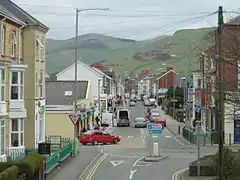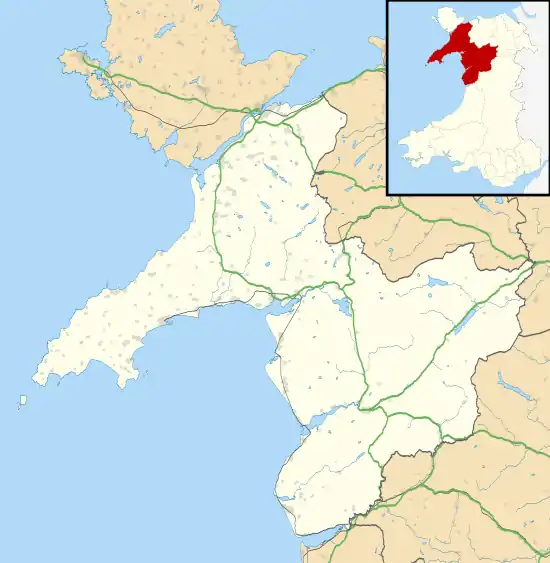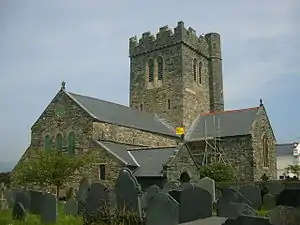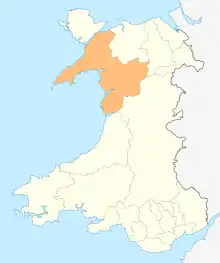Tywyn
Tywyn (Welsh: [ˈtəʊ.ᵻn]; in English often /ˈtaʊ.ɪn/), formerly spelled Towyn,[1] is a town, community, and seaside resort on the Cardigan Bay coast of southern Gwynedd, Wales. It was previously in the historic county of Merionethshire. It is famous as the location of the Cadfan Stone, a stone cross with the earliest known example of written Welsh, and the home of the Talyllyn Railway.
| Tywyn | |
|---|---|
 Tywyn High Street | |
 Tywyn Location within Gwynedd | |
| Population | 3,264 |
| OS grid reference | SH585004 |
| Principal area | |
| Ceremonial county | |
| Country | Wales |
| Sovereign state | United Kingdom |
| Post town | TYWYN |
| Postcode district | LL36 |
| Dialling code | 01654 |
| Police | North Wales |
| Fire | North Wales |
| Ambulance | Welsh |
| UK Parliament | |
| Senedd Cymru – Welsh Parliament | |
Toponymy
The name derives from the Welsh tywyn ("beach, seashore, sand-dune"): extensive sand dunes are still to be found to the north and south of the town.
In Middle Welsh, the spelling was generally Tywyn. In the Early Modern period, however, the spelling Towyn became common in Welsh in order to reflect a slight change in pronunciation at that time. That also came to be the usual spelling in English up to the latter part of the twentieth century. The modern spelling Tywyn better reflects the current pronunciation in modern Welsh as spoken in north Wales.[2] With the standardisation of the orthography of the Welsh language in the first part of the 20th century, the spelling Tywyn came to dominate. A referendum was held in 1968, with residents being asked to decide between Tywyn or Towyn.[3] In the 1970s Tywyn was accepted as the official name of the town in both languages.
In Welsh, the town is sometimes referred to as Tywyn Meirionnydd. In origin, this usage probably refers to the cantref of Meirionnydd, but is now generally understood as referring to the historical county of the same name. In English, during the late 19th century and until the middle of the 20th century, the town was sometimes called Towyn-on-Sea. The place-name element tywyn is found in many other parts of Wales, most notably Towyn near Abergele.[4]
History
Tywyn was the location of the first religious community administered by the Breton saint Cadfan upon his arrival in Gwynedd, prior to his departure to found a monastery on Bardsey Island off the Llyn Peninsula. The church contains some early material (see below).
Location

The town's historic centre lies about a kilometre from the beach, around the church of St Cadfan's. In the second half of the 19th century the town expanded considerably, mainly towards the sea.
To the north of the town lie the reclaimed salt marshes of Morfa Tywyn and Morfa Gwyllt, beyond which lie the Broad Water lagoon and the mouth of the Afon Dysynni. To the north-east lie the rich farmland of Bro Dysynni and the village of Bryncrug, and to the east the hills of Craig y Barcud and Craig Fach Goch. To the south towards Aberdyfi is the mouth of the Afon Dyffryn Gwyn and Morfa Penllyn.
The Tywyn coastal defence scheme, officially unveiled on 24 March 2011 by Jane Davidson (then Welsh Assembly Government Minister for Environment, Sustainability and Housing), provides a rock breakwater above the low-tide level, rock groynes, and rock revetment to protect 80 sea-front properties.[5] The costs of this civil engineering project was £7.62M, shared between the Welsh Assembly Government (£4.135M) and the European Union's Regional Development Fund (£3.485M).[6]
Demography and language
At the time of the 2001 census, 40.5% of the population were recorded as Welsh speakers. By the 2011 census this had decreased to 37.5%. These relatively high figures (given the town's demography) reflect the use of both Welsh and English as the medium of instruction in Ysgol Penybryn, the town's primary school. An Estyn inspection report in 2010 noted that about 11% of the children at the school came from homes where Welsh was the main language.[7]
The town's Welsh dialect has several notable features, with one Victorian observer stating that three languages were spoken there: English, Welsh and 'Tywynaeg'.[8] During the 1860s, in the town's British School, a 'Welsh stick' (a version of the Welsh Not) was used to punish children who were caught speaking Welsh.[9] Yet Welsh was the dominant language in Tywyn until the middle of the 20th century. L T C Rolt in his book 'Railway Adventure' recounts walking up the track of the Talyllyn Railway in 1950, and stopping to speak to railway workers only to discover they spoke no English. Tywyn is now a very anglicised town, with the majority of its population (52.8%) having been born in England according to the 2011 census. Likewise, slightly more respondents claimed an English-only identity (35.0%) than a Welsh-only identity (33.7%).[10]
Transport and tourism
The church is of interest for two medieval effigies, and for a stone inscribed with what is believed to be the oldest known writing in the Welsh language, dating back to the 8th century AD, and rescued from a local gateway in the 18th century.[11]
Improved transport links during the 19th century increased Tywyn's appeal as a tourist destination. In the early decades of that century, a creek of the river Dysynni allowed ships to approach the town's northern fringes, where there was a shipbuilding yard. The draining of the salt marsh and the channelling of the river brought this industry to an end,[12] but during the early part of that century the town was made more accessible by building new roads along the coast to Aberdyfi and Llwyngwril.
The railway arrived in the mid-1860s (first as the Aberystwith and Welsh Coast Railway, then as Cambrian Railways), and had a significant effect on the town. Tywyn railway station opened in 1863. The station is still open, and is served by the Cambrian Line.
Slate-quarrying in the Abergynolwyn area led to the building in 1865 of the Talyllyn Railway, a narrow-gauge line designed to carry slates to Tywyn. Two stations were opened in the town. Tywyn Wharf railway station was originally opened to enable slates to be unloaded onto a wharf adjacent to the main railway line. It is now the Talyllyn's western terminus and principal station. Pendre railway station was originally the passenger station, and now houses the locomotive and carriage sheds and works.
Notable visitors who stayed at Tywyn in the 19th century include:
- Thomas Love Peacock (1811, at Botalog)[13]
- Thomas Fremantle, 1st Baron Cottesloe (1818)
- Ignatius Spencer (1818)[14]
- Charles Darwin (1819, at Plas Edwards)[15]
- William Morris (1875)[16]
- Elizabeth Blackwell (exact date uncertain, at Brynarfor)[17]
The beach and its extensive promenade have long been key attractions. In 1877, a pier was built at Tywyn, but the structure only lasted a few months.[18] The street called 'Pier Road', which leads from the town to the beach, offers a suggestion as to its location. The promenade was completed in 1889 at the cost of some £30,000, paid for by John Corbett (1817–1901) of Ynysymaengwyn.
There has been extensive bungalow and caravan development in the vicinity.[11]
Other industries
Apart from tourism, agriculture has long been the most important industry in the area. Lead and copper used to be mined in the town's hinterland.
The Marconi Company built a Long Wave receiver station in Tywyn in 1914, working in duplex with the high-power transmitter station near Waunfawr. In 1921 the Tywyn and Waunfawr stations initiated a transatlantic wireless telegraph service with a similar RCA wireless transmitting station in New Brunswick, New Jersey, USA and RCA's receiver station in Belmar, New Jersey. This new transatlantic service replaced Marconi's obsolete transatlantic telegraph station in Clifden, Ireland following its 1922 destruction during the Irish Civil War.[19]
For most of the 20th century, the armed forces were a significant presence in Tywyn. The town was a major training ground for the amphibious warfare landings in the Second World War and had a strategic war base. Abandoned pillboxes may still be seen on the coast to the south of the town. The links with the armed forces came to an end when the Joint Service Mountain Training Centre at Morfa Camp closed in 1999.[20] Morfa camp is now in private ownership and many buildings are let as small storage units.
Facilities and notable features
Much of the town's infrastructure was put in place by an industrialist from the English Midlands, John Corbett, who in the 1870s decided to develop the town into a major tourist resort to rival Torquay. As well as constructing a row of boarding houses and a grand esplanade, he developed the water and sewerage system. He gave land and money for a new Market Hall, built to celebrate Queen Victoria's Diamond Jubilee in 1897. He paid for Brynarfor (formerly a private school originally called the Towyn Academy and then Brynarvor Hall School) to be opened as 'Towyn Intermediate School' in 1894. He refurbished the Corbet Arms Hotel (from then on spelled with two 't's), and also contributed to the Assembly Room (1893), now Tywyn Cinema. Plaques commemorating his generosity may still be seen on the north end of the promenade and on the Market Hall. Another commemorative plaque was on Brynarfor (now demolished), and his portrait was hung there when the school first opened. However, the anticipated grand watering-place never took off, and these additions to the town were never matched.[11]
In 1912, a drill hall was built in the Pendre area of the town for the Territorial Army (the 7th Battalion the Royal Welsh Fusiliers). The hall, now known as Neuadd Pendre, has recently been renovated, mainly with money from the National Lottery Big Lottery Fund and the Welsh Government.[21] The hall houses a 3-manual 9-rank Wurlitzer Organ which was originally installed in a cinema in Woolwich in 1937.[22]
After the First World War money was raised to build both the Tywyn Cottage Hospital (opened in 1922) and the Tywyn Institute (opened by David Lloyd George in 1926). The hospital is still in operation, but the institute is now closed.[23] It was the location of the town's library before a new library building was built next to it in the early 1970s.
The main schools in Tywyn are the primary school, Ysgol Penybryn, and the secondary school, Ysgol Uwchradd Tywyn.
Local places of interest include Craig yr Aderyn (Bird Rock), Castell y Bere, Llanfendigaid Estate and Llyn Mwyngil Talyllyn Lake. Hen Dyffryn Gwyn is a Grade II listed building dating from 1640 which retains many of its original features.[24]
Religion
For many centuries, St Cadfan's church was the only place of worship in the town, but since the 19th century there have been several.
Following the Methodist Revival, the Calvinistic Methodists established a cause (i.e. a branch) in Tywyn at the end of the 18th century. Bethel Calvinistic Methodist Church (Welsh-speaking Presbyterian Church of Wales) was established in 1815. The current chapel was built in 1871 and altered in 1887.[25] The chapel closed in early 2010 but services are still held in the vestry.
Bethany Calvinistic Methodist Chapel (English-speaking Presbyterian Church of Wales) was also built in 1871 as one of the 'Inglis Côs' ('English cause') chapels that were advocated by Lewis Edwards and fiercely criticised by Emrys ap Iwan. It was opened in part with a view to attracting the increasing numbers of visitors who were coming to Tywyn since the opening of the railway and who previously had been provided for only by the English services at St Cadfan's.[26] The noted pacifist George Maitland Lloyd Davies was minister of Bethany and also of Maethlon Chapel in nearby Cwm Maethlon (Happy Valley) between 1926 and 1930. Bethany closed in 2016.[27]
Ebeneser (Welsh-speaking Wesleyan Methodist Church in Wales) was first built between 1817 and 1820, with the current building dating from 1883.[28] John Cadvan Davies (1846–1923), Archdruid of Wales in 1923, was minister of Ebeneser between 1889 and 1892.[29]
Bethesda Independent Chapel (Welsh-speaking Congregationalist) was first built in 1820, enlarged in 1865 and rebuilt again in 1892.[30] It closed in January 2010.[31]
Tywyn Baptist Church (English-speaking)[32] was opened in 1900 and re-built in its present form in 1991.[33]
The Church of St David is the town's Roman Catholic church and is part of Dolgellau Deanery. In its grounds is a sculpture of St David in Welsh slate by John Skelton.
Sport
In Samuel Lewis's A Topographical Dictionary of Wales (1833) it is reported that popular horse races were held on land to the north of the town every September. Between 1904 and 1947, Towyn Golf Club (originally the Towyn-on-Sea Golf Club) was also located on land to the north of the town.[34]
The Towyn-on-Sea club opened with a 10-hole course in 1904, in 1906 a further eight holes were added. Attempts were made to re-establish the club following the Second World War but these proved unsuccessful.[35]
In the past Tywyn has had a rugby union team, and it now shares a football team with neighbouring Bryncrug (Tywyn & Bryncrug F.C.), playing their home matches in the village of Bryncrug. It also has a cricket club, Tywyn and District CC and a hockey team known as Dysynni Hockey Club. Also based in Tywyn is the Bro Dysynni Athletics Club.
Notable people
- See Category:People from Tywyn
- The Anwyl family of Tywyn, direct male line descendants of Rhodri ab Owain Gwynedd, a member of the House of Aberffraw
- Arthur ap Huw (d. 1570), vicar of St Cadfan's between 1555 and his death in 1570, notable patron of Welsh poets, and translator of counter-Reformation literature into Welsh.
- Tom Bradshaw (b 1992) Professional footballer for Millwall F.C and Wales FA
- Robert L. Chidlaw-Roberts (9 May 1896 – 1 June 1989), World War I flying ace.
- Robin Davies (16 January 1954 – 22 February 2010), Welsh television and film actor. Starred alongside Geoffrey Bayldon in Catweazle playing the part of Carrot.
- Evan Evans (Ieuan Fardd/Ieuan Brydydd Hir, 20 May 1731 – 4 August 1788), poet and scholar, was curate of St Cadfan's between 1772 and 1777.
- Edward Ernest Hughes (7 February 1877 – 23 December 1953), the first professor of history at University College, Swansea, was born in Tywyn, the son of a local policeman.
- Griffith Hughes (1707 – c. 1758) clergyman from the parish of Tywyn, author of The Natural History of Barbados.
- John Ceiriog Hughes ('Ceiriog', 25 September 1832 – 23 April 1887), poet, was stationmaster at Tywyn for a short period from 1870.
- Joseph David Jones (1827–1870, 'Eos Powys'), musician, was schoolmaster at Tywyn British School from 1851 to 1855. It was at Tywyn that he met his wife, Catherine Daniel of Penllyn.
- Sir Henry Haydn Jones (27 December 1863 – 2 July 1950), MP for Merioneth, was the son of Joseph David Jones and Catherine (née Daniel), and spent most of his life in Tywyn.
- John Daniel Jones (1865–1942), the renowned Congregationalist minister, was another son of Joseph David Jones and Catherine (née Daniel).
- Owen Wynne Jones ('Glasynys', 4 March 1828 – 4 April 1870), Welsh cleric, antiquary, author, and poet, died at Tywyn on 4 April 1870.
- Dai Lloyd (b. 1956), Plaid Cymru politician and Member of the National Assembly for Wales, was born in Tywyn.
- David Richards (Dafydd Ionawr) (22 January 1751 – 12 May 1827), poet, from Glanymorfa in the parish of Tywyn is the author of an englyn to his mother Ann Dafydd (d. 1785) which is preserved on a brass plate in St Cadfan's Church.
- R. Bryn Williams (1902–1981), Welsh-language writer, poet, playwright and historian is buried at Tywyn Cemetery.
See also
References
- The local branch of the Royal Air Forces Association still employs the name "Towyn and Aberdovey".
- Wmffre, Iwan. 2003. Language and Place-names in Wales: The Evidence of Toponymy in Cardiganshire. Cardiff: University of Wales Press, pp. 334–35. ISBN 0-7083-1796-0.
- "Towyn neu Tywyn? 1968". YouTube.
- The two places now use different spellings, partly for reasons of differentiation. Confusion between the two still occurs, however: Sat-nav mix up leaves pupils in Towyn not Tywyn, BBC News, 19 April 2013.
- BBC Online, £10m north Wales tidal flood defences open.
- Coastal Schemes with Multiple Funders and Objectives FD2635: Case Study Report 13 Tywyn Coastal Defence Scheme (2011).
- Williams, William Edwards. 2010. A report on the quality of education in Ysgol Penybryn, Tywyn, Gwynedd, p. 1.
- D. S. Thomas, 'Yr Ail Draethawd', in P. H. Hughes et al. (ed.), Ystyron Enwau ... ym Mhlwyfi Towyn, Llangelynin, Llanfihangel y Pennant, Talyllyn, a Phennal (Caernarfon, 1907), p. 122.
- Meirionnydd Archives, Gwynedd Archives Service, Towyn British School Log Book, Merionethshire, 1863–76, Gathering the Jewels: The website for Welsh heritage and culture Archived 11 July 2012 at the Wayback Machine
- Census statistics for Tywyn are available at Office for National Statistics, Neighbourhood Statistics: Tywyn Ward.
- Simon Jenkins, 2008, Wales: churches, houses, castles, Allen Lane, London, p. 244
- George Smith, Tywyn Coastal Protection Scheme Archaeological Assessment Archived 4 March 2016 at the Wayback Machine (Gwynedd Archaeological Trust Report No.555, 2004), p. 6 and fig. 3.
- Madden, Mary and Lionel. 1986. 'Edward Scott, Bodtalog, and his literary circle: Thomas Love Peacock, James and John Stuart Mill and William Owen Pughe'. National Library of Wales Journal, 24.3, pp. 352–57.
- Rev. Father Pius a Spiritu Sancto. 1866. The life of Father Ignatius of St. Paul, Passionist (The Hon. & Rev. George Spencer). London 1866, pp. 45–47.
- Lucas, Peter. 2001. 'Three weeks which now appear like three months: Charles Darwin at Plas Edwards'. National Library of Wales Journal, 32.2, pp. 123–46.
- Henderson, Philip. 1950. ed. The Letters of William Morris to his Family and Friends. London: Longmans, p. 69.
- Elizabeth Blackwell Letters, c. 1850–1884.
- Wilkinson, Jeremy. 1984. Tywyn Pier. Journal of the Merioneth Historical and Record Society, 9.4, pp. 457–71.
- Williams, Harri. 1999. Marconi and his wireless stations in Wales. Llanrwst: Gwasg Carreg Gwalch. ISBN 0-86381-536-7; Hogan Jr, John L. A New Marconi Transatlantic Wireless Service. Electrical World, 29 August 1914.
- Jones, Rees Ivor. 2000. The Military in Tywyn 1795–1999: The Warlike Side of a Small Welsh Seaside Town. Tywyn: the author.
- Neuadd Pendre Social Centre.
- The Tywyn Wurlitzer Archived 8 October 2012 at the Wayback Machine.
- BBC Online, Tywyn report highlights jobs, homes and tourism needs.
- "Hen Dyffryn Gwyn, Tywyn". British Listed Buildings. Retrieved 10 April 2016.
- Royal Commission on the Ancient and Historical Monuments of Wales, Bethel Chapel (Welsh Calvinistic Methodist), Tywyn.
- Royal Commission on the Ancient and Historical Monuments of Wales, Bethany Chapel (English Presbyterian and Calvinistic Methodist), Tywyn.
- Gareth Wyn-Williams, 'Plans to convert old church into private home', Cambrian News, 21 July 2018.
- Royal Commission on the Ancient and Historical Monuments of Wales, Ebenezer Methodist Chapel (Wesleyan), Tywyn.
- Morgan, Gwylfa H. 1983. Canmlwyddiant Ebeneser Tywyn 1983. Tywyn.
- Royal Commission on the Ancient and Historical Monuments of Wales, Bethesda Welsh Independent Chapel, Tywyn.; Jones, Richard. 1970. Dathlu agor Capel Bethesda Tywyn, Mehefin 21, 1820. Abertawe: Gwasg John Penry.
- Capel arall yn cau, Dail Dysynni, Rhagfyr 2009/Ionawr 2010.
- "Who We Are". Tywyn Baptist Church. Retrieved 30 May 2019.
- Royal Commission on the Ancient and Historical Monuments of Wales, Tywyn Baptist Church.
- Gwynedd Archives: Meirionnydd Record Office, Towyn Golf Club Records.
- 'Towyn-on-Sea Golf Club, Gwynedd', Golf's Missing Links.
External links
| Wikimedia Commons has media related to Tywyn. |
| Wikivoyage has a travel guide for Tywyn. |


